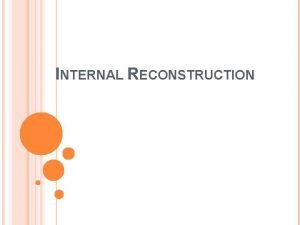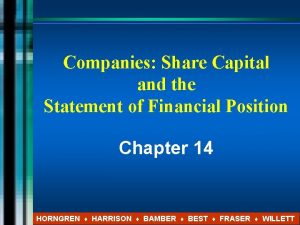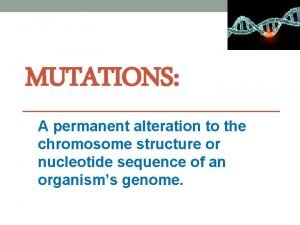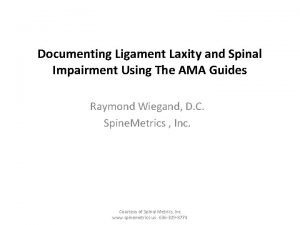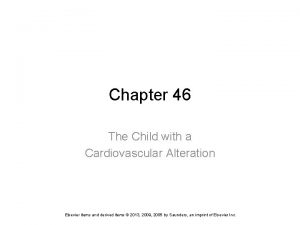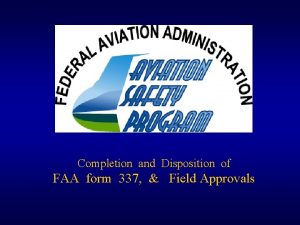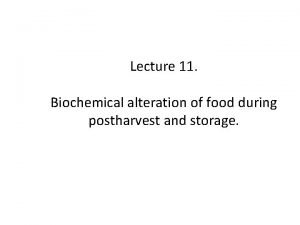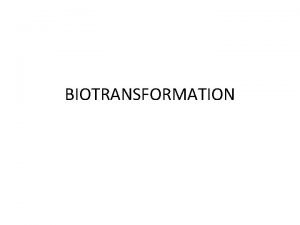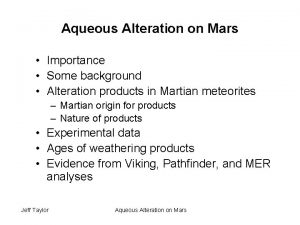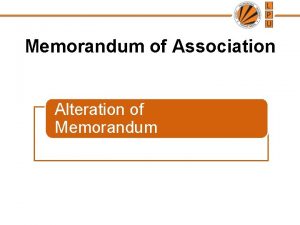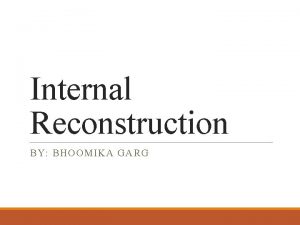INTERNAL RECONSTRUCTION ALTERATION OF SHARE CAPITAL According to
















- Slides: 16

INTERNAL RECONSTRUCTION

ALTERATION OF SHARE CAPITAL According to Section 94 of the Companies Act , a limited company can, if authorised by its articles of association, alter the capital clause of its memorandum of association in any of the following ways: 1. Increase its share capital by issue of new shares. Accounting entries are the same. 2. Consolidate all or part of its existing shares of smaller amounts into shares of larger amounts. E. g. Rs. 5, 000 share capital divided into 50, 000 shares of Rs. 10 each, consolidated into 5, 000 shares of Rs. 100 each. 2

Share Capital A/c Dr. (Rs. 10) 5, 000 To Share Capital A/c (Rs. 100) 5, 000 (Being consolidation of 50, 000 equity shares of Rs. 10 each into 5, 000 shares of Rs. 100 each fully paid) 3. Sub- divide its shares of higher denomination into shares of smaller denomination. In case of partly paid up shares , the proportion between the paid up and unpaid amount on the shares continues to be the same after sub-division as before. Share Capital A/c Dr. (Rs. 100) 5, 000 To Share Capital A/c (Rs. 10) 5, 000 Being consolidation of 50, 000 equity shares of Rs. 1003 each into 5, 000 shares of Rs. 10 each fully paid)

4. Convert all or any of its fully paid up shares into stock or reconvert that stock into fully paid up shares. Equity Share Capital A/c Dr. To Equity Stock A/c 5, 00, 000 (Being conversion of 50, 000 equity shares of Rs. 10 each fully paid into Rs. 5, 000 equity stock ) Reverse entry will be passed for conversion of equity stock into fully paid equity shares. 5. Cancel those shares which have not been taken up i. e. , decrease its unissued capital without resulting in the reduction of paid up capital. It does not require any journal entry because it does not affect paid up capital in any way. 4

INTERNAL RECONSTRUCTION OR CAPITAL REDUCTION Internal Reconstruction means the reduction of capital to cancel any paid up share capital which is lost or unrepresented by available assets. This is generally resorted to write off the past accumulated losses of the company. Reduction of capital is unlawful except when sanctioned by the court. The issued share capital of a company represents the security on which the creditors rely. The uncalled capital acts as a future security for the company’s creditors. Therefore any reduction of capital reduces the security of the creditors. 5

However, in genuine cases, a company is permitted to reduce its share capital by Section 100 in any of the following ways: 1. By extinguishing or reducing the liability on any of its shares in respect of share capital not paid up. E. g. capital of a company consists of 2, 000 equity shares of Rs. 10 each on which Rs. 8 has been paid, now being reduced to a fully paid share of Rs. 8. Share Capital A/c Dr. (Rs. 10) 16, 000 To Share Capital A/c (Rs. 8) 16, 000 (Being 2, 000 equity shares of Rs. 10 each, Rs. 8 per share paid up converted into 2, 000 equity shares of Rs. 8 each fully paid up. 6

2. By paying off any paid up capital which is in excess of the needs of the company out of accumulated profits. (i) Share Capital A/c Dr. 1, 60, 000 To Shareholders A/c 1, 60, 000 (Being the amount to be repaid to shareholders on reduction of paid up capital) (ii) Shareholders A/c To Bank A/c 1, 60, 000 (Being the amount paid off) (iii) Profit &Loss A/c Dr. 1, 60, 0000 To General Reserve A/c 1, 60, 000 7 (Being transfer on repayment of share capital)

The court consults creditors for 1 st and 2 nd type of capital reduction. If some creditors are unwilling to give their consent to such capital reductions the company will have to settle their claims before getting sanction from the court. 8

3. Where any paid up share capital is being reduced without reducing the liability on the shares. E. g. A share of Rs. 10 on which Rs. 8 has been paid up is being reduced to a share of Rs. 10, Rs. 6 paid up. Share Capital A/c Dr. To Capital Reduction A/c 2 2 The court ordinarily gives sanction for 3 rd type of capital reduction without consulting the creditors because creditor’s interest is in no way affected by such reduction. 9

4. Where any paid up share capital is being reduced , reducing the liability on the shares. E. g. a share of Rs. 10 on which Rs. 8 has been paid up is being reduced to fully paid share of Rs. 6. Share Capital A/c Dr. (Rs. 10 ) 8 To Share Capital A/c (Rs. 6) To Capital Reduction A/c 6 2 5. By any other method approved by the court. . 10

ACCOUNTING ENTRIES ON INTERNAL RECONTRUCTION 1. When the face value of the shares is changed or the rate of dividend on preference shares is changed, it is treated as change in the category of the share capital. (Old) Share Capital A/c Dr. To (New) Share Capital A/c To Capital Reduction(or Reconstruction ) A/c If the face value of the shares or the rate of dividend on preference shares is not changed on reduction of share capital, it does not result in the change of the category of the share capital. Share Capital A/c Dr. To Capital Reduction A/c 11

2. If any sacrifice has been made by creditors and debentureholders: Creditors A/c Dr. Debentures A/c Dr. To Capital Reduction A/c 3. If the value of any asset is appreciated: Respective Asset A/c Dr. To Capital Reduction A/c 4. When any contingent liability (say Sales tax) arises and is to be paid immediately: Capital Reduction A/c Dr. To Liability (Sales Tax) Payable A/c 12 Liability (Sales Tax) Payable A/c To Bank A/c

5. When amount of capital reduction is utilised for writing off fictitious assets, past losses and excess value of other assets: Capital Reduction A/c Dr. To Profit &Loss A/c To Goodwill A/c To Preliminary Expenses A/c To Discount on Shares or Debentures A/c To Patents or Trade Marks A/c To Plant and Machinery A/c To Other Assets A/c To Capital Reserve A/c ( Balance Amount) 13

Ø Ø The amount to be written off cannot exceed the amount credited to Capital Reduction Account. . If any reserve appears on the liabilities side of the Balance Sheet, the same may be utilised in writing off the accumulated losses and assets. The amount written off or appreciated in respect of fixed assets under a scheme of reconstruction must be shown for five years in the balance Sheet. The words ‘And Reduced’ should be added to the name of the company if directed by the court for such period as the court deems fit. 14

REORGANISATION THROUGH SURRENDER OF SHARES Under this method shares are subdivided into smaller denominations and to facilitate capital reorganisation shareholders are made to surrender a part of their holdings. Such surrendered shares are usually utilised to reduce or extinguish debentures and trade liabilities. The portion of shares surrendered but not reissued are to be cancelled. The claims foregone by creditors and debentureholders are transferred to capital reduction (or reorganisation) account which will be utilised to write off losses. 15

16
 Define internal reconstruction
Define internal reconstruction Alteration of capital
Alteration of capital Total share capital
Total share capital Alterations in various aspects of society
Alterations in various aspects of society A permanent alteration that changes a dna sequence
A permanent alteration that changes a dna sequence Ligamenta flava
Ligamenta flava Chapter 46 the child with a cardiovascular alteration
Chapter 46 the child with a cardiovascular alteration Faa 337 example
Faa 337 example Alteration of food
Alteration of food Alteration or alternation
Alteration or alternation เปล
เปล Maigreur constitutionnelle
Maigreur constitutionnelle Chemical alteration definition
Chemical alteration definition Alteration in urinary elimination
Alteration in urinary elimination Unauthorised alterations to common property
Unauthorised alterations to common property Net working capital refers to
Net working capital refers to Source of capital reserve
Source of capital reserve
